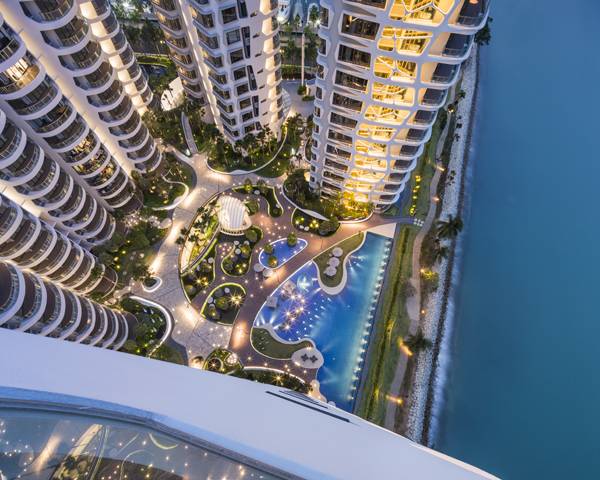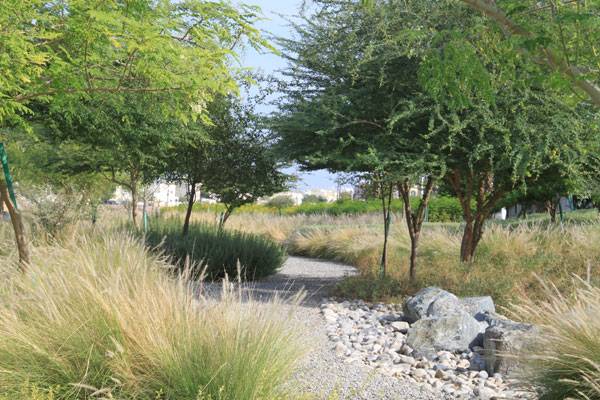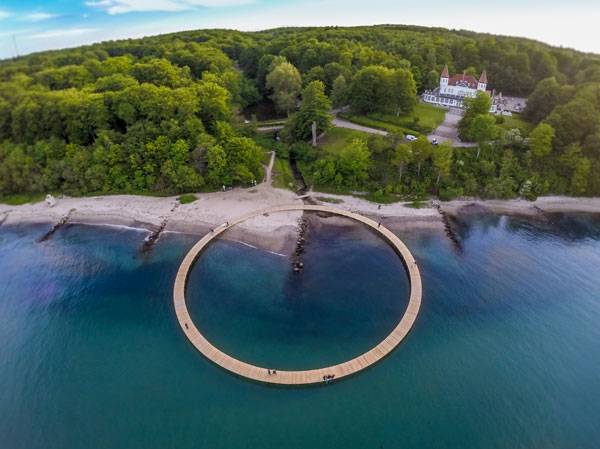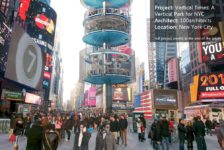Article by Sophie Thiel We take a closer look at landscape architecture in Asia that also makes for great tourist destinations. In our third article about landscape architecture tourist destinations, we take a closer look at projects in Asia. As the world’s biggest continent, Asia seems to also be the most diverse part of the Earth. It spreads from icy Siberia in the north to tropical Indonesia in the south, and reaches from Saudi Arabia in the west to Japan in the east. So it doesn’t come as a surprise that there are thousands of must-see places spread all over Asia. Yet not many of those are the outcome of modern landscape architecture, since the profession has only recently enjoyed growing popularity. Nevertheless, you will find some of the world’s greatest landscape architecture in the following list of Top 10 Asian landscape architecture spots. This list expands upon two previous LAN articles, by Michelle Biggs and Sophie Thiel:
Landscape Architecture in Asia
10. Cape Royale Resort – Sentosa, Singapore, by TROP: terrains + open space
Are you tired of lousy hotel gardens? Or do you want to simply enjoy a special treat while staying in Singapore? Check out the Cape Royale Resort garden, which creates a magically peaceful reality in the middle of the chaos and rush of the busy city of Singapore. This resort is one of the area’s biggest tourist attractions, with beautiful views of the sea. The creation of the hotel garden seems to magically connect water features, sculptures, differentiated paving, and original planting.

Image credit: TROP: terrains + open space
There are countless pools where you can swim, walk, and sunbathe on cozy lounge chairs in shallow water areas. Those who do not like to be in the main garden can find their own serene spot under the shade of native trees. When even a garden’s colors harmoniously mirror the natural surroundings of the sea, the beach, the plants, and the sky, you know there was nothing left to chance in the design. Come and enjoy high-end landscape architecture at Cape Royal Resort.

Organic landscape platform, inspired by coral reefs, is a combination of Bubble Planters, Main Living Corridor, Reflecting Pond, Floating Wooden Terraces and the Gigantic Pool. Image credit: TROP: terrains + open space
“
Oman is the obvious choice for those seeking out the modern face of Arabia while wanting still to sense its ancient soul,” says the travel website
lonelyplanet.com. Indeed, this relatively unknown country holds an abundance of natural beauty and towns that retain their traditional charms.

Wadi Al Azeiba. Image courtesy of Atelier Jacqueline Osty & associés.
One of those towns is Muscat – the capital – home to a successful park called
Wadi Al Azeiba. The word “wadi” describes a gateway for water during storms in the rainy season. The city of Muscat redefined its formerly abandoned wadi and embedded it into a new park. The slightly terraced ground contains the catch basin — a naturally planted area with loads of walkways — beneath the lawn and palm tree part that reaches out to the surrounding neighborhoods. This modern park serves as the capital’s new green alleyway that is central to many hubs of activity and is one more reason to visit the beautiful city of Muscat.

Wadi Al Azeiba. Image courtesy of Atelier Jacqueline Osty & associés.
The organization
“Free the Bears” works tirelessly to combat the illegal trade in bears and provides a safe sanctuary for rescued bears in the Tat Kuang Si Rescue Centre. The new
merchandise store will enable this international organization to sell items in order to receive much-needed donations that will allow them to continue their ongoing efforts to protect bears in Laos and beyond.

Bamboo Trees in construction © Building Trust international
The simple structure of the bamboo canopy was built in conjunction with the local community and celebrates this versatile material, showing that traditional can be modern. Visitors to the rescue center are now not only able to enjoy seeing one of Laos’ most endangered species and be educated about the life and threats of this precious species, but also are able to admire the bamboo canopy of the new merchandise store.

Canopy designed by Atelier COLE, constructed by Building Trust. © Building Trust international
Thailand is one of the most popular tourist destinations in Southeast Asia for Europeans and Australians. Travelers who want to enjoy outstanding, harmonious, modern landscape architecture should not miss
CSG Headquarters while staying in the capital. The well-developed landscape design has helped to bind together the disparate companies’ buildings and has managed to create a harmonic and attractive stage on which to enjoy the environment through a mixed language of architecture and nature.

The result, which can be seen in the aerial view, is a dynamic synchronization of permeable-impermeable, new-old, constructed-void space that provides different experiences for pedestrian users of the site. Image courtesy of Landscape Architects of Bangkok
The LAB bureau designed subtle ground-level changes that communicate the diversity of meaningful layers on site. Additionally, they used curved geometry in a simple three-dimensional design pattern – accompanied by the site furniture and emphasized by materials — to organize the open space. The resulting lines as a physical element have a uniquely powerful invigorating effect on the landscape. See for yourself what influence such lines can have on your movement pattern, and enjoy the landscape views of one of the most powerful Thai companies.

A bird’s eye view of newly designed SCG landscape through the preservation of its history with a contemporary form for the future. Image courtesy of Landscape Architects of Bangkok
Everyone in the world of landscape architecture should have heard about this Chinese hope-giving park by now. The popularity of
Quzhou Luming Park remains undiminished since the first part was opened in 2015.

Quzhou Luming Park. Photos courtesy of Turenscape
Designed by the famous
Turenscape bureau, this park will showcase three design concepts: minimal intervention to preserve the unique red sandstone hills, a productive urban farming landscape on the fertile floodplain soil, and water resilience in order to respect the natural water flow in the floodplain. If you plan a trip to China, you should definitely visit Quzhou and get inspired by its Luming Park. (Read about another Turenscape success story that just won the first prize in an international competition. The promising Russian project — called
The resilient ribbon — was featured in a LAN article by
Eleni Tsirintani.)
5. Warde – Jerusalem, Israel, by HQ Architects Culturally, it is difficult to clearly assign Israel to a continent. However, it belongs to Asia geographically, adding lots of wonderful landscape architecture projects to this continent. The art installation Warde is one of those projects, and offers a playful, interactive environment. Ever since these eye-catching red flowers were constructed, they have invited people not only to actively engage with them, but to notice a site that was previously neglected. The flowers open and close in reaction to people passing by or every time a tram arrives.

Warde in the evening. Photo credit: Dor Kedmi
Through this inflation and deflation mechanism, the flowers provide shade during day and spend light at night — at least as long as people stand under those giant red flowers resembling poppies. Go try it out yourself! You can learn more about Israel’s top landscape architecture in LAN articles written by
Win Phyo,
Yulia Georgieva, and
Erin Tharp:
4. Lalaport Toyosu – Tokyo, Japan, by Earthscape Tokyo is a city that never sleeps and never ceases to amaze both its inhabitants and its visitors. It’s a metropolis that successfully combines loads of thousand-year-old cultural heritage with the latest trends. Lalaport Toyosu is a shopping and art center located on a man-made island in Tokyo Bay. The site offers not only a mall with more than 500 shops, museums, and a radio station, but also various open spaces. Landscape architecture lovers will be amazed by the spectacular oceanic adventure offered through a park and public plaza.

LaLaport Toyosu. Photo courtesy of Earthscape
The entire landscape of
Lalaport Toyoso was designed as an ocean — the plaza’s ground plane emulates waves, there are benches formed as corals, and seating elements that imitate islands, which break through the wavy surface. Additionally, there are many relics that remain on site as a reminder of its history, and many different fountains and water basins allow children to play.

LaLaport Toyosu. Photo courtesy of Earthscape
Every year, masses of tourists are drawn to the beaches of Taiwan at night to witness the spectacle of bioluminescent algae. The small town of Matsu is now home to the art installation
The Blue Island by industrial designer Island Chen. This glass box is the prototype of a bio-digital installation of a visible ecosystem that recreates the natural habitat of the toxic bioluminescent algae.

The hydrodynamics makes Micro-algae generates bioluminescence. Photo credit: Island Chen
The aim of the project is to act as an educational tool, helping people to understand that the aesthetically pleasing algae have detrimental effects on marine environments. While on your next trip to East Asia, take the chance to not only enjoy the beautifully glowing waters at night, but also to educate yourself and support the installation as a much safer and viable option for eco-tourism.

The visible ecology educate people the knowledge of algae production. Photo credit: Island Chen
There is not much new to say about the famous ChonGae Canal Redevelopment Project. In few words: It may be the best restored river in the world. Before becoming a major public gathering place for the people of Seoul, the Cheonggyecheon River was a highly polluted, covered wastewater canal surrounded by elevated and at-grade infrastructure dividing the city.

“Korea-Seoul-Cheonggyecheon-2008-01″ by stari4ek – originally posted to Flickr as fest2-01. Licensed under CC BY-SA 2.0 via Commons
The redevelopment of more than 11 kilometers pf the river has not only allowed people to rediscover the qualities of the river, but also to reinvent the way people relate to it. Every landscape architect should see this project once and be inspired by its beautiful success story. Unsurprisingly, the Cheonggyecheon River is listed in the Top 5 nature sights of Seoul on Tripadvisor and was also featured in our article
10 Cities That Are Reinventing The Relationship With Their Rivers, by Yuliya Georgieva.
Kontum Indochine Café – Kontum, Vietnam, by Vo Trong Nghia Architects Another bamboo project? Yes, but one of the most beautiful ones existing. This architectural bamboo masterpiece is part of a hotel café that wanted to offer an outstanding dining experience. The exceptional form of the bamboo columns of
Indochine Café was inspired by traditional Vietnamese fishing baskets.

Kontum Indochine Café. Photo credit: Hiroyuki Oki
The loose structure of the bamboo ceiling provides not only shade, but also maximizes the wind flow through the building. However, due to special characteristics, it resists even severe storms during the windy season. A shallow artificial lake sits right next to the café, reinforcing the natural open space concept that has been established. The combination of light, bamboo, and water has resulted in an amazing creation not to be missed on your next journey to Vietnam.

Kontum Indochine Café. Photo credit: Hiroyuki Oki
As you can see, Asia is a continent full of heterogeneity and different design styles. Of course, there are many more projects worth seeing, and it was hard to choose only 10. However, the most precious projects are those from which we can learn and take along inspiration for ourselves. This list should remind you that wherever you go, you should seek out such landscape architecture.
Keep your eyes open and have fun on your trip to Asia. Which projects do you want to visit immediately? What designs do you think are you missing from this list? Let us know in the comment section below! Go to comments
Recommended Reading
Return to Homepage
Published in Blog




















![Transitioning to Information Modeling Workflows [WEBINAR]](https://land8.com/wp-content/uploads/2018/03/vw-land8-224x150.png)







